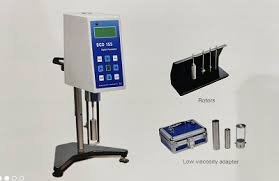Calibration of Brookfield Viscometer

Calibration of Brookfield Viscometer in Pharmaceuticals
1. Introduction
A Brookfield viscometer is widely used in pharmaceutical industries to measure the viscosity of semi-solids, creams, gels, and certain liquid formulations.
Regular calibration ensures accuracy, reproducibility, and compliance with GMP and pharmacopoeial requirements.
2. Objective
-
To verify the accuracy of viscosity readings.
-
To ensure instrument performance is within acceptable limits.
-
To maintain traceability to certified standards.
3. Principle
Calibration involves comparing viscosity readings of certified viscosity standard fluids (traceable to NIST) with their known values at a controlled temperature.
If the observed values fall within the acceptable tolerance range specified by the manufacturer (usually ±1% for Brookfield), the viscometer is considered calibrated.
4. Equipment & Materials
-
Brookfield viscometer (LV, RV, or appropriate model)
-
Certified viscosity standard fluids (e.g., Brookfield Silicone Oil Standards)
-
Temperature-controlled water bath
-
Appropriate spindles for the instrument model
-
Stopwatch (if needed for manual models)
5. Procedure
-
Preparation
-
Clean the spindle and sample chamber with a suitable solvent and dry completely.
-
Set the viscometer to the correct speed and spindle as per manufacturer’s instructions.
-
Maintain the test fluid at the specified calibration temperature (commonly 25 ± 0.1 °C).
-
-
Measurement
-
Immerse the spindle into the viscosity standard fluid up to the immersion groove.
-
Start the viscometer and allow readings to stabilize (as per instrument guidelines).
-
Record the viscosity reading.
-
-
Comparison
-
Compare the measured viscosity to the certified value of the standard at the same temperature.
-
Repeat for all required viscosity ranges using different standards.
-
-
Acceptance Criteria
-
Reading should be within ±1% of full-scale range (or as specified by the manufacturer).
-
If results are outside the limit, perform maintenance/servicing and recalibrate.
-
6. Calibration Frequency
-
Before first use
-
Annually (or as per SOP)
-
After repairs, spindle replacement, or suspected malfunction
7. Documentation
-
Viscometer ID and model
-
Calibration date
-
Standard fluid lot number and certified value
-
Spindle number, speed, and temperature
-
Observed viscosity and % deviation
-
Pass/Fail status
-
Signatures of analyst and reviewer
8. Regulatory References
-
Brookfield Viscometer Operating Manual
-
USP <912> Viscosity
-
ISO 2555: Plastics — Resins in the Liquid State or as Emulsions or Dispersions — Determination of Apparent Viscosity Using a Rotational Viscometer

